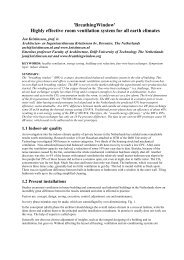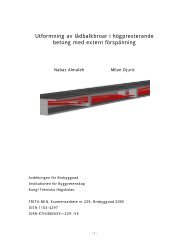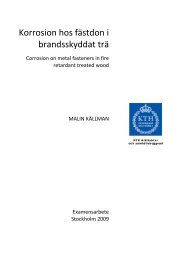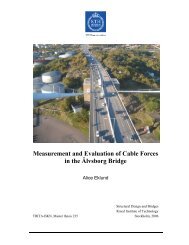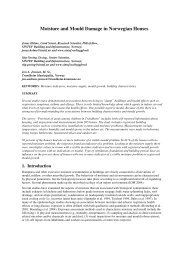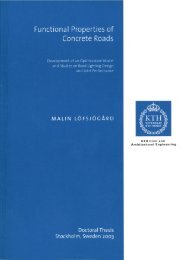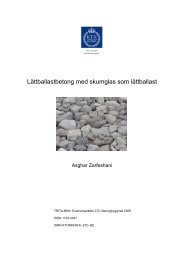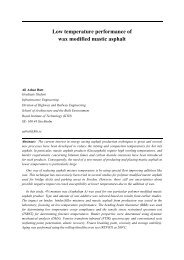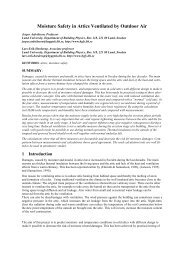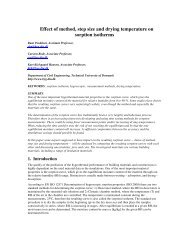Fig. 4: Maximum moisture content of the OSB sheathing during the simulated 3-year period at different European locations depending on the vapour retarder of the stud wall and the insulation material of the ETICS. It has been already mentioned that the rainwater leakage rate of 1% of the total amount if wind-driven rain hitting the wall in the ASHRAE draft standard 160 [BSR/ASHRAE 2006] is not a worst case scenario. T<strong>here</strong>fore, the simulations are repeated for the best performing walls with mineral wool insulation, this time with higher rainwater leakage rates. Fig. 5 shows the OSB moisture content of the stud wall when 1%, 2%, 3% or 4% of the wind-driven rain load is deposited evenly over the thickness of the OSB sheathing. While the wall can still handle an increase in rain water penetration rate by the factor of 2 compared to the specifications in the ASHRAE draft standard 160, a further increase (3% or 4% of wind-driven rain load) will lead to OSB moisture content peaks in excess of 20 M.-%. Fig.5: Temporal variations of OSB sheathing moisture content beneath the ETICS with mineral wool insulation in Hannover with different rainwater leakage rates.
5. Summary and Conclusions This investigation shows that ETICS on lightweight structures pose no moisture problem in cold and moderate climates when the detailing of joints and openings is well done, i.e. t<strong>here</strong> is no rainwater leakage. This holds for all locations investigated. However, if water leakage cannot be <strong>complete</strong>ly excluded and t<strong>here</strong>fore the North American Standard assumptions - penetration of 1% of the driving rain load - are applied this picture changes, making the drying potential of this type of wall assemblies an essential feature. The normal ETICS composed of vapour retarding EPS insulation slabs cannot provide much drying towards the exterior and may t<strong>here</strong>fore be responsible in part for increasing the risk of moisture damage for the underlying substrate. The application of a humidity controlled vapour retarder (PA-film) instead of a conventional polyethylene film at the interior side of the building assembly enhances the overall drying potential of the construction by allowing some vapour diffusion towards the interior spaces. But only in warmer locations, like Wilmington in North Carolina or Lisbon, the effect of employing such a vapour retarder is great enough to compensate for small rainwater leaks. The best but also most expensive solution to reduce the risk of moisture related problems in EITCS wall assemblies would be to replace the expanded polystyrene (EPS) by a high-density mineral wool insulation. However, even this solution will not work if the rainwater penetration exceeds the amount specified in the ASHRAE draft standard. T<strong>here</strong>fore, proper detailing and good workmanship are essential prerequisites when classical ETICS systems are installed. Alternative ways of solving the rain penetration problem are currently being developed and tested in North America [Onysko & Thivierge 2007]. Many systems now provide a drainage plane between the substrate and the ETICS and flashing to force the water out at the bottom of the wall. Other systems keep the face seal approach and rely on more sophisticated detailing and flashing. In both cases the long-term performance is still unknown. In order to avoid a repetition of the problems with ETICS applied to wood frame structures in North America, it is important to communicate this issue and possible solutions to the European construction trades. Hygrothermal simulations may help to raise the awareness to the risks of damage and the importance of qualified stuff involved in the application of ETICS especially for locations having high wind driven rain loads. 6. References BSR/ASHRAE Standard 160P (Sept. 2006). Design Criteria for Moisture Control in Buildings, Public review draft. Cheple, M. & Huelman, P. (2000). Literature Review of Exterior Insulation Finish Systems and Stucco Finishes, Report MNDC/RP B80-0130, University of Minnesota. Desjarlais, A.O., Karagiozis, A.N. & Aoki-Kramer, M. (2001): Wall Moisture Problems in Seattle. Buildings VIII proceedings, ASHRAE, 8p. Karagiozis, A. & Kumaran, K. (1997). Drying Potential of EIFS Walls: Innovative Vapor Control Strategies. STP 1339, American Society for Testing and Materials (ASTM), West Conshohocken. Künzel H.M. (1995). Simultaneous Heat and Moisture Transport in Building Components, - One- and twodimensional calculation using simple parameters, Fraunhofer IRB Stuttgart. Künzel, H.M. (1998a). Drying of Masonry with Exterior Insulation. Proceedings of the Fifth International Masonry Conference, British Masonry Society, No. 8, Stoke-on-Trent, p. 245-250. Künzel, H.M. (1998b). The Smart Vapor Retarder: An Innovation Inspired by Computer Simulations, ASHRAE Transactions, Vol 104, Pt. 2, pp 903-907. Künzel, H.M. and Leimer, H.-P. (2001). Performance of Innovative Vapor Retarders Under Summer Conditions. ASHRAE Transactions, Part. 1, p. 417-420. Künzel, H, Künzel, H.M. & Sedlbauer, K. (2006). Long-term Performance of External Thermal Insulation Systems (ETICS), ACTA Architectura 5,Vol 1, p. 11-24. Lawton, M. (1999). Vancouver’s Rotting Condominium Problem – How Did We Get into This Mess? Journal of Thermal Envelope & Building Science, Vol 22, p. 356-363. Nisson, N. & Best, D.( 1999). Exterior Insulation and Finish Systems. Compilation of <strong>article</strong>s from EDU- Newsletter, Cutter Information Corp., Arlington. Onysko, D. and Thivierge, C. (2007): Drainage and Retention of Water by Cladding Systems – Part 3: Drainage Testing of EIFS Wall Systems. CMHC Research Report, Canada.



